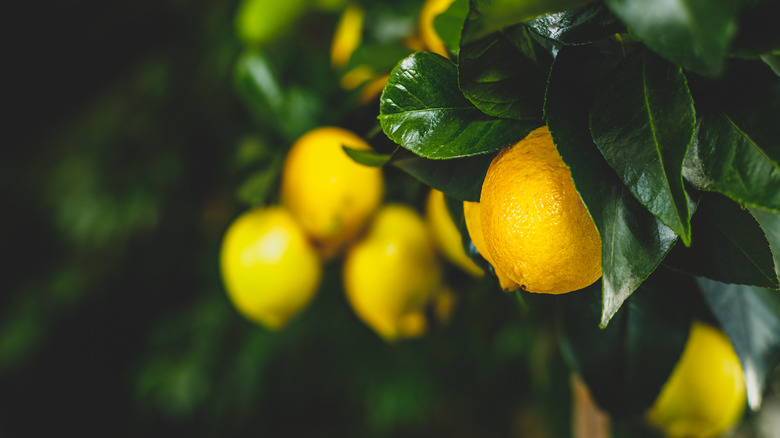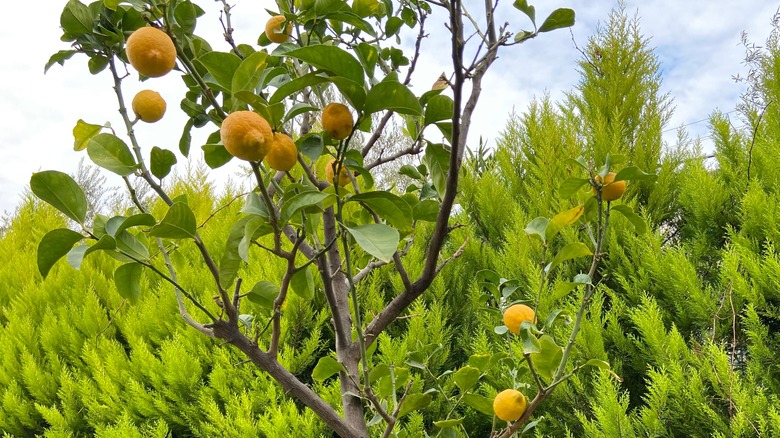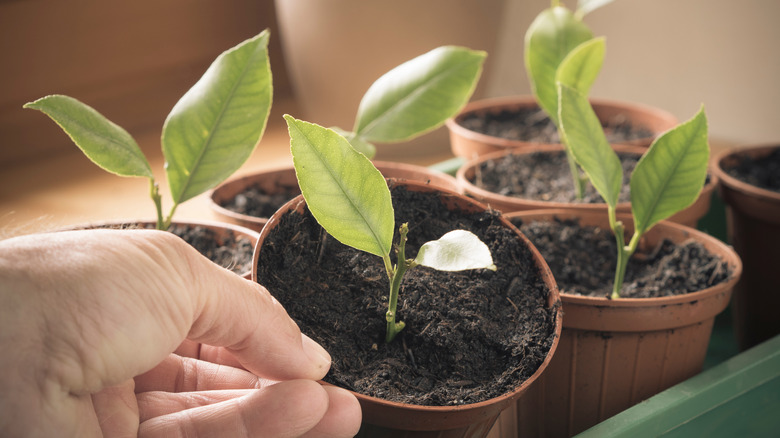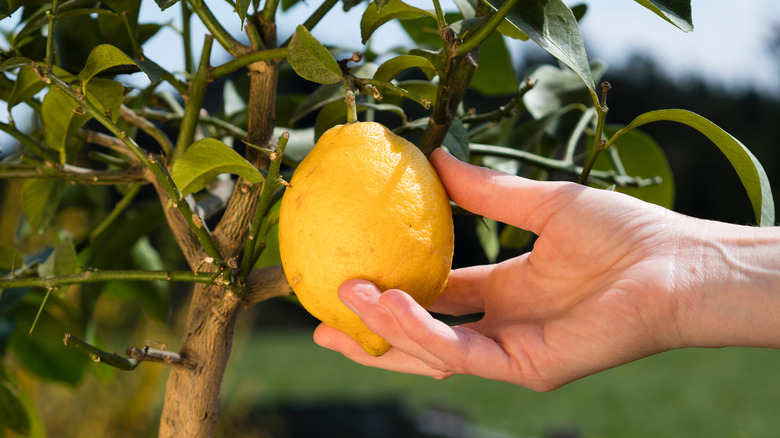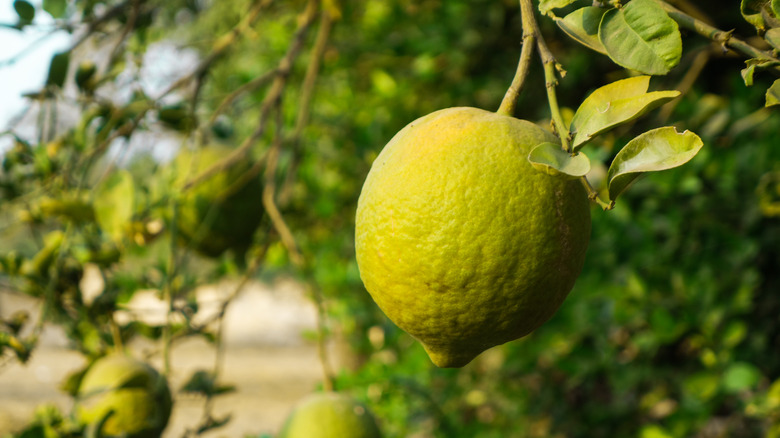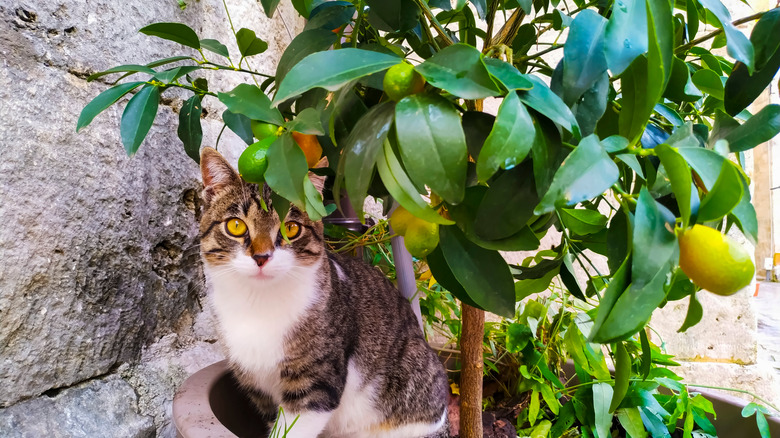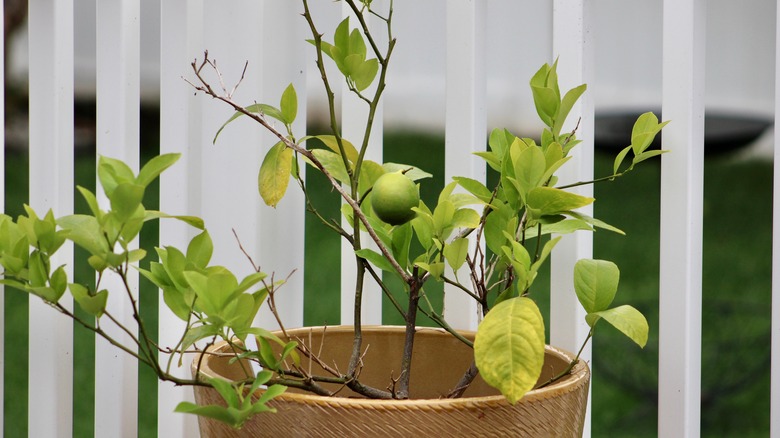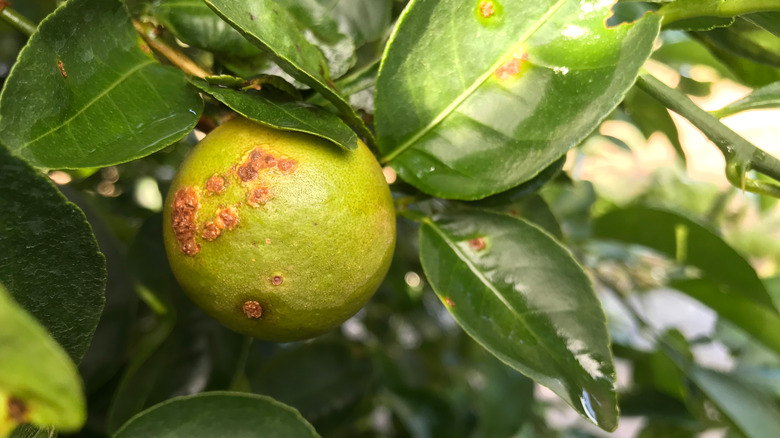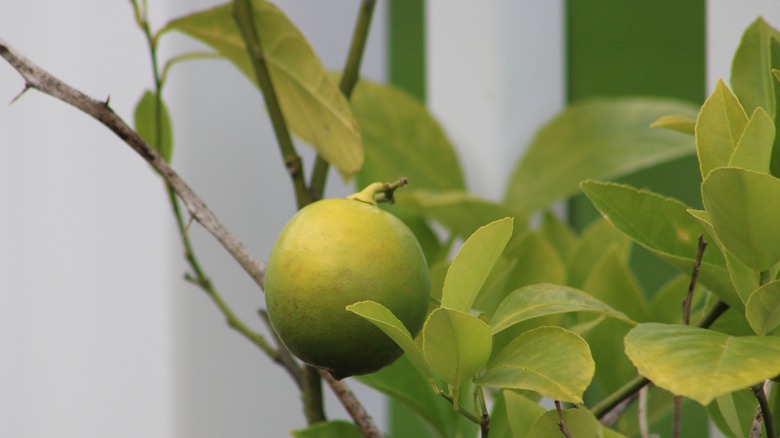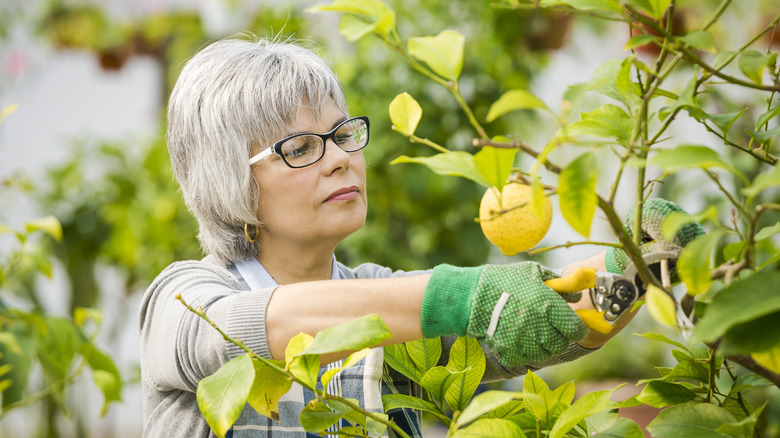How To Grow And Care For A Meyer Lemon Tree
Among the most common and beloved types of lemon trees are the Meyer lemon trees, or Citrus x limon 'Meyer,' in the Rutaceae family, as told by North Carolina State Extension. They are most often grown for ornamental use, though the fruit it produces is edible. The lemons are not the same as the ones you would buy at the grocery store. Though they do look similar, Meyer lemons are actually sweeter in taste and tend to be used in desserts or lemonade, as they are technically a cross between a lemon and a mandarin orange. Other types of lemons include the Avalon lemon, Verna lemon, Lisbon lemon, and Ponderosa lemon, via Minnetonka Orchards.
Meyer lemon trees can be identified by their waxy green leaves that grow to be about 3 to 6 inches in length, ovate yellow fruit, white blossoms, and erect growth habits. They bear fruit in the fall and winter unless they are grown indoors where they may begin producing in the spring. The lemons will first appear small and green, but they ripen to a golden, yellow, or orange color when they are ready to harvest. Meyer lemon trees are easy to grow as long as you provide them with the right conditions. With warm temperatures, consistently moist soil, and plenty of sun, you can have a thriving lemon tree in no time.
How to use Meyer lemon trees in the garden
Meyer lemon trees can be grown inside, in the garden, or on your porch, depending on the region you live in. As per Garden Products, the trees prefer USDA hardiness zones 9 through 11 and temperatures between 50 and 80 degrees Fahrenheit. Of course, if you live in colder regions, you may still grow your Meyer lemon trees outdoors in pots during warmer months and bring them inside as the weather becomes chilly.
Native to China, as told by This Old House, Meyer lemon trees that we know and love today are actually the second variety grown in the United States. This variety is more insect and disease-resistant. When you grow it in your garden, you don't have to worry about it quickly becoming sick or infecting other plants and trees nearby. Typical garden-grown Meyer lemon trees become 6 to 10 feet tall when planted in the ground and a few feet shorter when planted in pots. Their vibrant leaves, flowers, and fruit make them great focal points in any yard. Just make sure that they will be able to receive plenty of sunlight and humidity.
How to grow a Meyer lemon tree
A Meyer lemon tree can be grown from seed or propagated from an existing plant. To grow a Meyer lemon tree from seeds, you'll need a Meyer lemon, a knife, paper towels, a self-draining pot, and potting soil. According to DIY Home and Garden, you can start by cutting open your lemon and gathering the undamaged seeds. Gently peel off their shells and put them into a paper towel soaked with water. Place the folded paper towel into a plastic bag and put it in a dark place. In about 10 days, the seeds should sprout. At this time, you will need to fill your small pot with soil and plant each of the seeds into it. Water it thoroughly and wait for it to grow.
Propagation from cuttings is slightly easier — for this, you'll need a Meyer lemon tree, a self-draining pot, potting soil, scissors, and rooting hormone, explains Gardenologist. Begin the process by cutting off 8 to 10-inch branches that have no fruit or flowers and at least two leaf nodes. Then, pluck off all the leaves on the lower half of the branch. Cut the end of the stem at a 45-degree angle and dip it into your rooting hormone. Finally, you can plant the cutting into a pot filled with soil and water it generously. In about eight weeks, the cutting will take root as long as you keep it in an indirectly sunny area.
How to care for a Meyer lemon tree
Meyer lemon trees can be very easy to care for as long as you provide them with the conditions they need. Two of the most important things to give a growing lemon tree are sunlight and water. These trees require as much as eight hours of direct sunlight per day, as described by Garden Products. In addition to this, they need consistently moist soil. Despite the fact that they love the humid air in states such as Florida and California, they do not like wet conditions. Their soil should never be soggy and their roots should not sit in water. If you are keeping your Meyer lemon tree in a dry environment indoors or out, make sure to spray their leaves with water regularly or set up another device to keep the area around them humid.
These trees prefer being planted in soil that is loamy or sandy with a pH range between 5.5 and 6.5, but they can be planted in almost any kind of soil given that they are fertilized properly. When you own a Meyer lemon tree, you should supply it with fertilizer during its growing season in the spring, summer, and fall. A tree like this one enjoys a few different types, including high-nitrogen fertilizer, slow-release all-purpose fertilizer, and natural fertilizers such as fish emulsion and liquid kelp. Try out what you have on hand to see what works with your lemon tree.
Lemon tree varieties
The Meyer lemon tree is one variety of lemon trees out of many. All varieties of lemons come from the family of Rutaceae and the genus and species of Citrus limon. As told by Purdue, it's unknown exactly where the first lemon grew, but it's likely somewhere near northwestern India. From there, lemons have spread all over Europe, Asia, and the Mediterranean, causing other varieties of lemons to claim nativity to other regions around the world. Today, there are about 40 different types of lemons being grown and distributed. Here are a few of the most popular varieties used today.
-
Citrus x limon 'Lisbon' is among the most common lemons sold in the United States. The tree produces lemons larger than a Meyer lemon tree and is more resistant to bad weather, including very hot and cold conditions.
-
Citrus x limon 'Eureka' was first planted in Los Angeles, CA in 1858. It can bear fruit all year long.
-
Citrus x limon 'Monachello' has mostly been grown in Italy. The lemons are not juicy and the trees are slow-growing. Still, it is popular among citrus growers.
-
Citrus pyriformis 'Ponderosa' has lemons with round bodies and skin that is lumpy and ribbed. Most often these trees are grown for ornamental use.
-
Citrus x limon 'Berna,' sometimes referred to as "Bernia", "Verna", or "Vernia," has fruit that looks much like Lisbon lemons. However, the lemons can be dry and the trees can be threatened by disease, making them less desirable.
Are Meyer lemon trees toxic?
Lemon trees are non-toxic to humans, but they can be toxic to pets. In humans, lemons of many varieties can be beneficial to our health. Many cultures worldwide use the lemon rind, lemon juice, and lemon essential oils for cooking and medicine. According to Purdue, juice from a lemon can be used as a febrifuge, an antiscorbutic, an astringent, and a diuretic. Lemon juice on its own can be used to relieve gingivitis, inflammation, or prevent the common cold.
In pets, essential oils from lemons can cause a range of problems. Thus, the tree should be kept away from them. Oils from the leaves and roots of the trees as well as from the lemon skin can lead to vomiting, diarrhea, dermatitis, and depression after ingestion, as warned by the ASPCA. If you want to grow a Meyer lemon tree, but you have pets, it's best to keep the tree in a spot where they can't reach it and watch your pets closely. Growing your own Meyer lemons is not worth a trip to the veterinary hospital, or worse.
How to repot a Meyer lemon tree
Repotting a Meyer lemon tree is no different from repotting any other type of citrus tree. To get started, as per Petal Republic, you'll need slightly acidic citrus tree potting soil and a self-draining pot that is about ¼ inch larger than the previous container. No citrus tree can live in the same pot for its entire life, so you need to plan to repot yours about once every two years for young trees and once every four years for mature trees. Repotting your Meyer lemon tree at this interval will allow it to thrive as it makes it less susceptible to becoming rootbound or nutrient deficient. Make sure you are repotting during your tree's growing season in the spring or summer to avoid as much shock and stress as possible.
To get started with the repotting process, gently take your tree out of its pot and break up the dirt surrounding the roots to untangle them. Then, fill your new pot about a third of the way up with fresh potting soil. Place your tree into the pot and backfill with more soil until it's secure. Pat the dirt firmly around the base of the tree to secure it. Water your newly repotted tree and set it in a warm, sunny spot.
Common pests and diseases with Meyer lemon trees
There are some diseases specific to citrus trees that you'll want to work hard to discourage from affecting your Meyer lemons, or else your tree may fail to produce any viable fruit at all. Specifically, these are citrus canker (shown above), lemon or citrus scab, and a persistent virus known as citrus tristeza, per Garden Guides. Few of these issues can be reversed once they've taken hold, so prevention is key. Keep your landscape tidy and keep your trees pruned and free of debris. For new growers, talk to someone at a local nursery about resistant varieties like the Improved Meyer Lemon (Citrus x meyeri 'Improved').
Sooty mold, botrytis blight, and anthracnose are fungal diseases that can affect lots of different kinds of plants; they just tend to be more problematic in the hot and humid environments where people are most likely to be growing lemon trees (via Rural Sprout). Do your best to control aphid infestations by employing insecticidal soaps and knocking individual bugs off the foliage with a strong spritz from the garden hose. Copper-based fungicides and neem oil may prove equally effective as you tend to your citrus grove. Finally, consider introducing beneficial insects such as ladybugs, parasitic wasps, and spiders, all of which will help reduce aphids and citrus leaf miners. Yet another citrus-specific issue to be aware of, citrus leaf miners are actually very small moths whose larvae can infest and quickly wreak havoc on lemon tree foliage.
Lemon tree leaf droop
Droopy leaves deserve your attention because they are often your tree's way of telling you that trouble has just started brewing. Unless the problem is immediately evident — like your tree is desperate for a drink of water — you'll want to investigate further, especially if the leaves are sagging on a regular basis. Lemon Tree Guide notes that lack of light, under or overwatering, and extreme temperature swings can all be the culprit. Take in any environmental changes to pinpoint temporary causes of stress and fix them as best you can. If improper watering is causing harm, you'll need a permanent solution, such as a drip irrigation system or a different schedule.
Malnourishment is another issue that causes drooping leaves. It may also result in pale, yellowing, or speckled foliage. Nutrient deficiencies are more common in potted plants, but can also affect trees in the yard. UC Master Gardeners recommends feeding trees with a fertilizer that offers a ratio of two times as much nitrogen than phosphorous or potassium. Furthermore, trace minerals are necessary for healthy citrus. These can be found in a liquid kelp fertilizer concentrate which you'll dilute with water according to the manufacturer's instructions, advises Epic Gardening. The seaweed extract contained in these formulations has been shown to encourage sweeter-tasting and longer-lasting fruit.
When and how to prune a Meyer lemon tree
Proper pruning is very important in maintaining a healthy Meyer lemon tree full of fruit. This is a task best tackled early in the fall or early in the spring. The first thing to do is cut away any branches showing signs of damage, decay, or disease. Next, look for branches that cross each other. Eastside Tree Works explains that, left as is, crossing branches will scrape against each other and cause irritation to the bark. The resulting cuts act as invitations to disease and pest infestations.
Before getting started with shaping, survey your tree from a few steps back. For a Meyer lemon tree, the goal is to guide its growth pattern outwards more than upwards, so branches headed straight up to the sky can be the next to go. Now, take another step back to see where the sun is having trouble getting through to the center branches. It may seem logical that you'd want the fullest tree possible, but in reality, all parts of your tree need sufficient airflow and access to sunlight. Gently thinning it out so those interior branches receive a flush of light and oxygen will improve overall fruit production. It will also cut back on potential issues with mold since fungi much prefer damp and dark environments.
